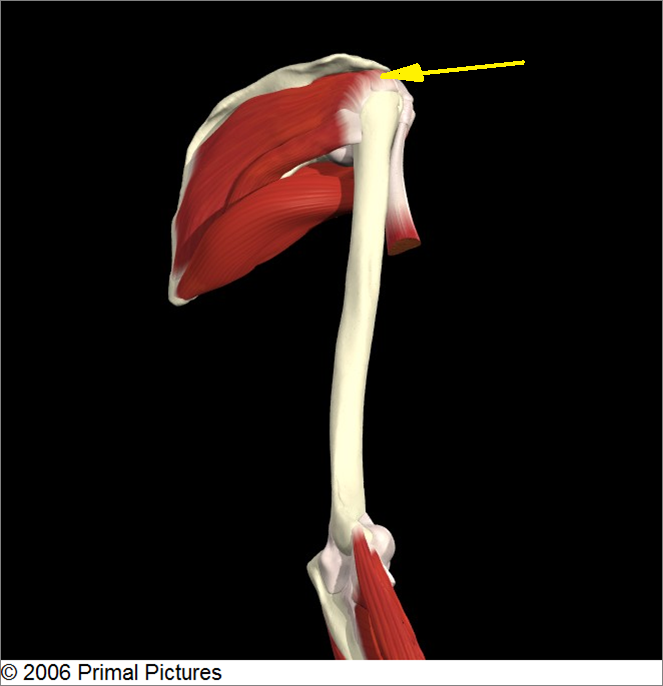Posted September 8, 2010
Brand New Season….OF INJURIES
So it’s not even a day after labor day, the gym is packed with returning exercisers and those looking to get started, and then there are people like this running around…..
And of course, with all these people hitting the gym again, it wouldn’t be September without at least THREE people coming up to me to ask about their new-found injuries from attacking the weight stacks.
I have no problem with people putting in the effort to see self improvement, so I will gladly offer to help if I can if someone wants to figure out what may be limiting their ability to work out with the best intensity possible.So today, we’re going to look at the number one bane of existence for many recreational weight lifters:
The Rotator Cuff
The rotator cuff is a group of muscles tight to the shoulder joint. It consists of the infraspinatus, supraspinatus, teres minor, and subscapularis. Don’t worry, there won’t be a test on this. The main one to think about is the supraspinatus, at the top of the humerus and under the acromion process.
This little guy gets beat up all the time, especially if the rest of the cuff isn’t doing it’s job properly and making sure the head of the humerus sits in the cup of the glenoid fossa. If the cuff is weak or if the person has poor posture and stresses the cuff too much, it won’t be able to stabilize the humerus and if any overhead movements are being performed, the humerus may glide in the cup rather than roll, the way it should. With this glide, the humerus will move vertically and pinch the supraspinatus in between the head of the humerus and the bony acromion process above. Feel the outer edge of your shoulder and you’ll feel the acromion. Now if we keep beating the hell out of this little guy with repeated poor movements, it will get irritated and start referring pain right in the middle of the delt muscle, and it will make you want to rub it to feel better.
“But Dean,” I hear you asking. “Why doesn’t the scapula just turn to give the arm some more room to move when we’re raising the arm?” Well, people tend to have poor posture and slouch a lot, which causes the spine to curve and reduces the ability of the scapula to roll into protraction and retraction. Try this one out, you cheeky buggers: Sit up tall and then raise your arms over head. Pretty easy, right?? Yeah, I know. Now slouch like a mutha and try to raise your arms over head. Come on. Do it. What’s the problem? Can’t get it up?? HA HA HA!! ……ehhhh.
Anyway, when the scapula doesn’t move properly, there is no way we can reposition the shoulder. The rotator cuff gets put under too much pressure, and the humerus will eventually glide right into the supraspinatus. We bang the hell out of it, and all of a sudden the muscle starts to fray and become weaker and eventually rupture if we keep it up.
Now for the good news: if we spend about five minutes doing some pre-hab exercises to reposition the spine and get the scapula moving, we can limit the possibility of causing any damage to these little guys, and we can let them do the work they need to take care of the joint. Some basics are:
scaption dips
hanging shoulder shrugs
pushup plus
wide arm scap pull flyes
After doing these, a good idea would be to build up slowly into the movement patterns that will inevitably cause some kind of trauma to the joint if done improperly. Try to limit movements in the following directions until you get your act together and quit being lame:
Overhead pressing
side raises near or above parallel
upright rows
bench press, especially incline barbell press
elastic rotator cuff work
“What!?! You don’t think we should do rotator cuff strengthening!?!?” No, I don’t. Primarily because a lot of the problem isn’t coming from having a weak rotator cuff muscle, but a shoulder that isn’t positioned properly (vertically on the back, it’s instead slightly horizontal because of slouching), and from immobility of the scapula. If we keep working the hell out of it, without repositioning the scapula, we’ll just keep feeding into the same problem. It’s kind of like hitting your head with a hammer and wondering why the Advil isn’t strong enough. Stop hitting yourself!!!!
Once we fix these, the rotator cuff should be able to re-balance and work properly without too much glide of the joint, and if needed, we could always work on rotator cuff strengthening as part of the shoulder mobilizing series. Later this week, we’ll go through a basic series on rotator cuff strengthening.
When in doubt, just start training with me. I need to pay for a wedding next year.
[gravityform id="3" name="Blog Post Capture. " title="false"]
